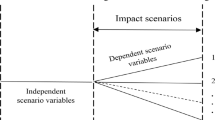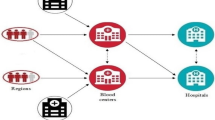Abstract
In disaster relief, one major concern is to have an efficient network to supply and distribute critical items such as blood to the affected areas. Based on a real case study, a tailored disaster relief blood supply chain problem is carried out for the responsive and reliable supply of blood. The case study necessitates incorporating three criteria, (1) urgency (U) of the injured and their priority-based demand, (2) the fairness (F) of blood distribution among the demand points, and (3) the risk (R) factor arising from uncertain nature of the network parameters and potential threat of disruptions (thereafter called U.F.R). Arisen from disaster condition, two major risk factors have been tracked by a robust optimization framework to cope with the operational risk (input uncertainty) as well as the disruption risk. Also, since the disaster may interrupt the SC activities such as blood collection processes, the SC facilities must be located on the most ideal place where is practically decided based on a number of criteria. Thus, the case calls for a group multi-criteria decision making method developed for the problem. To accommodate the requirements of the case study, a mixed integer robust equity-based bi-objective formulation (REBF) is proposed. Computational experiments of our case study reveal that the REBF can make a trade-off between costs and fairness in the quantity of deliveries and achieve a reliable solution in the disaster emergency case.











Similar content being viewed by others
References
Abdulwahab, U., & Wahab, M. I. M. (2014). Approximate dynamic programming modeling for a typical blood platelet bank. Computers & Industrial Engineering,78, 259–270.
Abolghasemi, H., Radfar, M. H., Tabatabaee, M., Hosseini-Divkolayee, N. S., & Burkle, F. M. (2008). Revisiting blood transfusion preparedness: Experience from the Bam earthquake response. Prehospital and Disaster Medicine,23(5), 391–394.
Afshar, A., & Haghani, A. (2012). Modeling integrated supply chain logistics in real-time large-scale disaster relief operations. Socio-Economic Planning Sciences,46(4), 327–338.
Beck, A., Bayeff-Filloff, M., Bischoff, M., & Schneider, B. M. (2002). Analysis of the incidence and causes of mass casualty events in a southern Germany medical rescue area. Der Unfallchirurg,105(11), 968–973.
Beliën, J., & Forcé, H. (2012). Supply chain management of blood products: A literature review. European Journal of Operational Research,217(1), 1–16.
Cheraghi, S., & Hosseini-Motlagh, S. M. (2017). Optimal blood transportation in disaster relief considering facility disruption and route reliability under uncertainty. International Journal of Transportation Engineering,4(3), 225–254.
Choi, T. M., Cheng, T. C. E., & Zhao, X. (2016). Multi-methodological research in operations management. Production and Operations Management,25(3), 379–389.
Deng, H., Yeh, C. H., & Willis, R. J. (2000). Inter-company comparison using modified TOPSIS with objective weights. Computers & Operations Research,27(10), 963–973.
Duan, Q., & Liao, T. W. (2013). A new age-based replenishment policy for supply chain inventory optimization of highly perishable products. International Journal of Production Economics,145(2), 658–671.
Ensafian, H., Yaghoubi, S., & Yazdi, M. M. (2017). Raising quality and safety of platelet transfusion services in a patient-based integrated supply chain under uncertainty. Computers & Chemical Engineering,106, 355–372.
Fahimnia, B., Jabbarzadeh, A., Ghavamifar, A., & Bell, M. (2017). Supply chain design for efficient and effective blood supply in disasters. International Journal of Production Economics,183, 700–709.
Fazli-Khalaf, M., Khalilpourazari, S., & Mohammadi, M. (2017). Mixed robust possibilistic flexible chance constraint optimization model for emergency blood supply chain network design. Annals of Operations Research, 1–31. https://doi.org/10.1007/s10479-017-2729-3.
Ghatreh Samani, M. R., & Hosseini-Motlagh, S. M. (2018). An enhanced procedure for managing blood supply chain under disruptions and uncertainties. Annals of Operations Research, 1–50. https://doi.org/10.1007/s10479-018-2873-4.
Gunpinar, S., & Centeno, G. (2015). Stochastic integer programming models for reducing wastages and shortages of blood products at hospitals. Computers & Operations Research,54, 129–141.
Habibi, M., Paydar, M. M., & Gangraj, E. A. (2017). Designing a bi-objective multi-echelon robust blood supply chain in disaster. Applied Mathematical Modelling. https://doi.org/10.1016/j.apm.2017.11.004.
Haijema, R., van der Wal, J., & van Dijk, N. M. (2007). Blood platelet production: Optimization by dynamic programming and simulation. Computers & Operations Research,34(3), 760–779.
Hatefi, S. M., & Jolai, F. (2014). Robust and reliable forward–reverse logistics network design under demand uncertainty and facility disruptions. Applied Mathematical Modelling,38(9), 2630–2647.
Hogan, D. E., & Burstein, J. L. (Eds.). (2007). Disaster medicine. Philadelphia: Lippincott Williams & Wilkins.
Holland, L. (2006). Role of ABO and Rh type in platelet transfusion. Laboratory Medicine,37(12), 758–760. https://doi.org/10.1309/Q8E44ULBGM6HN0LX.
Jabbarzadeh, A., Fahimnia, B., & Seuring, S. (2014). Dynamic supply chain network design for the supply of blood in disasters: A robust model with real world application. Transportation Research Part E: Logistics and Transportation Review,70, 225–244.
Kamyabniya, A., Lotfi, M. M., Naderpour, M., & Yih, Y. (2018). Robust platelet logistics planning in disaster relief operations under uncertainty: A coordinated approach. Information Systems Frontiers,20(4), 759–782.
Khalilpourazari, S., & Arshadi Khamseh, A. (2017). Bi-objective emergency blood supply chain network design in earthquake considering earthquake magnitude: A comprehensive study with real world application. Annals of Operations Research, 1–39. https://doi.org/10.1007/s10479-017-2588-y.
Koehler, R. H., Smith, R. S., & Bacaner, T. (1994). Triage of American combat casualties: The need for change. Military Medicine,159(8), 541–547.
Manopiniwes, W., & Irohara, T. (2017). Stochastic optimisation model for integrated decisions on relief supply chains: Preparedness for disaster response. International Journal of Production Research,55(4), 979–996.
Norouzi, N., Tavakkoli-Moghaddam, R., Ghazanfari, M., Alinaghian, M., & Salamatbakhsh, A. (2012). A new multi-objective competitive open vehicle routing problem solved by particle swarm optimization. Networks and Spatial Economics, 12(4), 609–633.
Osorio, A. F., Brailsford, S. C., & Smith, H. K. (2015). A structured review of quantitative models in the blood supply chain: A taxonomic framework for decision-making. International Journal of Production Research,53(24), 7191–7212.
Ramezanian, R., & Behboodi, Z. (2017). Blood supply chain network design under uncertainties in supply and demand considering social aspects. Transportation Research Part E: Logistics and Transportation Review,104, 69–82.
Ransikarbum, K., & Mason, S. J. (2016). Multiple-objective analysis of integrated relief supply and network restoration in humanitarian logistics operations. International Journal of Production Research,54(1), 49–68.
Rezaei-Malek, M., Tavakkoli-Moghaddam, R., Zahiri, B., & Bozorgi-Amiri, A. (2016). An interactive approach for designing a robust disaster relief logistics network with perishable commodities. Computers & Industrial Engineering,94, 201–215.
Rezaie, F., & Panahi, M. (2015). GIS modeling of seismic vulnerability of residential fabrics considering geotechnical, structural, social and physical distance indicators in Tehran using multi-criteria decision-making techniques. Natural Hazards and Earth System Sciences,15(3), 461–474.
Sabzehchian, M., Abolghasemi, H., Radfar, M. H., Jonaidi-Jafari, N., Ghasemzadeh, H., & Burkle, F. M. (2006). Pediatric trauma at tertiary-level hospitals in the aftermath of the Bam, Iran Earthquake. Prehospital and Disaster Medicine,21(5), 336–339.
Salehi, F., Mahootchi, M., & Husseini, S. M. M. (2017). Developing a robust stochastic model for designing a blood supply chain network in a crisis: A possible earthquake in Tehran. Annals of Operations Research, 1–25. https://doi.org/10.1007/s10479-017-2533-0.
Samani, M. R. G., Torabi, S. A., & Hosseini-Motlagh, S. M. (2018). Integrated blood supply chain planning for disaster relief. International Journal of Disaster Risk Reduction,27, 168–188.
Sha, Y., & Huang, J. (2012). The multi-period location-allocation problem of engineering emergency blood supply systems. Systems Engineering Procedia,5, 21–28.
Shemshadi, A., Shirazi, H., Toreihi, M., & Tarokh, M. J. (2011). A fuzzy VIKOR method for supplier selection based on entropy measure for objective weighting. Expert Systems with Applications,38(10), 12160–12167.
Torabi, S. A., & Hassini, E. (2008). An interactive possibilistic programming approach for multiple objective supply chain master planning. Fuzzy Sets and Systems,159(2), 193–214.
Valsami, S., Dimitroulis, D., Gialeraki, A., Chimonidou, M., & Politou, M. (2015). Current trends in platelet transfusions practice: The role of ABO-RhD and human leukocyte antigen incompatibility. Asian Journal of Transfusion Science,9(2), 117.
Van Dijk, N., Haijema, R., Van Der Wal, J., & Sibinga, C. S. (2009). Blood platelet production: A novel approach for practical optimization. Transfusion,49(3), 411–420.
Yu, C. S., & Li, H. L. (2000). A robust optimization model for stochastic logistic problems. International Journal of Production Economics,64(1–3), 385–397.
Zahiri, B., & Pishvaee, M. S. (2017). Blood supply chain network design considering blood group compatibility under uncertainty. International Journal of Production Research,55(7), 2013–2033.
Author information
Authors and Affiliations
Corresponding author
Appendix
Appendix
In this section the blood matching alternatives and priority orders for each blood group are presented in Tables 17 and 18, respectively. Blank cells denote unallowable transfusion alternatives for each group. According to the tables, the injured with any blood groups and Rh (D)− can only receive blood with Rh (D)− while the injured with Rh (D)+ can be transfused blood with both Rh (D)+and Rh (D)−. The blood recipients with group \( AB^{ + } \) are the universal recipients who can receive blood from any blood groups and with any Rh (D) (See Tables 16, 17, 18, 19, 20).
Rights and permissions
About this article
Cite this article
Cheraghi, S., Hosseini-Motlagh, SM. Responsive and reliable injured-oriented blood supply chain for disaster relief: a real case study. Ann Oper Res 291, 129–167 (2020). https://doi.org/10.1007/s10479-018-3050-5
Published:
Issue Date:
DOI: https://doi.org/10.1007/s10479-018-3050-5




